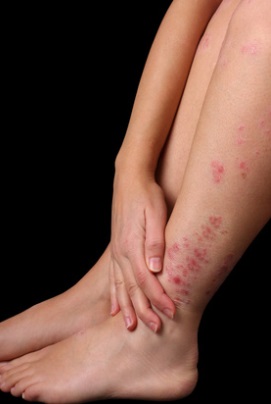
Psoriasis skin disease is a condition in which the body produces skin cells faster than normal. Excess skin cells build up and form dry, scaly patches that itch and are sometimes painful. There are several different types of conditions and you can follow the link to learn about the different psoriasis types.
The condition usually begins during the late teen years or early adulthood. It’s a chronic condition with no real cure, but there are treatments that can relieve uncomfortable symptoms. If you’re wondering what psoriasis looks like, here are more pictures.
Information Psoriasis Patients Should Know
Psoriasis skin disease has been linked to many other conditions, some of them quite serious. Having psoriasis doesn’t mean you’ll get any of these conditions, but since you are at higher risk for them, you should discuss your risk factors with your doctor and, when possible, take steps to reduce your risk. For instance, maintaining a healthy weight and exercising regularly can reduce your risk of high blood pressure and heart disease.
- Psoriatic arthritis – This can lead to joint damage and can be quite painful and debilitating.
- Type 2 diabetes – Doctors aren’t quite sure why, but people with psoriasis are at increased risk for type 2 diabetes. People with psoriasis are also more likely than those without the condition to be obese. Doctors aren’t sure why that is the case, either, but obese people do have a higher risk of diabetes than those of average weight.
- High blood pressure – This is yet another thing not well understood by doctors, but people with psoriasis are at increased risk for high blood pressure.
- Cardiovascular disease – The increased risk of cardiovascular disease may be related to the higher rates of obesity and high blood pressure found in people with psoriasis.
- Kidney disease – People with moderate to severe psoriasis are at increased risk for kidney disease.
- Parkinson’s disease – People with psoriasis are more likely than those without the condition to develop Parkinson’s disease, a serious neurological condition.
- Eye disorders – People with psoriasis are at increased risk for eye disorders like blepharitis, conjunctivitis (pink eye), and uveitis.
- Psychological disorders – According to the Mayo Clinic, people with psoriasis may develop psychological problems like depression, social anxiety, or poor self-esteem due to the effect of the condition on their quality of life and concerns about their appearance. Psychological complications of psoriasis should not be overlooked. If you’re struggling with depression, anxiety, or other psychological difficulties, talk to your doctor or make an appointment with a counselor.

Treatment For Psoriasis Skin Disease
Perhaps the information people want most about psoriasis is how to treat it. Since the condition can cause considerable discomfort and can have a significant impact on a person’s life, that’s understandable. If you suffer from psoriasis, you have a number of treatment options.
Topical treatments – These often include salicylic acid or corticosteroids, to reduce the redness, swelling, and inflammation of psoriasis, along with other ingredients to relieve itching and discomfort and help skin heal.
Oral, injected, and intravenous medications – Oral, injected, and intravenous medications, including retinoids, methotrexate, cyclosporine, and others, are used for severe cases of psoriasis or when topical treatments don’t work. They carry the risk of pretty severe side effects, however.
Phototherapy – Controlled exposure to sunlight or ultraviolet light (UVB) can help with psoriasis.
Natural treatments – Many people prefer natural treatments for psoriasis, in part because they generally carry much less risk of side effects. You can read about homeopathic remedies for psoriasis and learn about home remedy options by following these links. We’d also like to tell you about our favorite natural treatment for psoriasis, which contains ingredients like jojoba oil, peppermint oil, magnesium oxide, and zinc oxide, in addition to salicylic acid. Together, the combination of ingredients reduces redness and inflammation while also relieving itching and discomfort. Follow this link to learn more about Terrasil Psoriasis Therapy Cream.
For More Information on Psoriasis
For more information on psoriasis skin disease, talk to your doctor, or make an appointment with a dermatologist, a doctor that specializes in skin disorders. You can also contact the National Psoriasis Foundation. And as always, feel free to email us if you have any questions and we’ll do our best to help or refer you to the right place to get the information you need.
Additional Reading:
Psoriasis on Genitals – How to treat psoriasis on sensitive areas.
Psoriasis and Diet – Foods to eat and foods to avoid to help reduce the symptoms of psoriasis.
Home Remedies For Psoriasis – Comparison of popular home remedies including home remedies for scalp psoriasis.
Homeopathic Psoriasis Treatments – Guide to homeopathic remedies for psoriasis. Do they work?
Natural Treatments For Psoriasis – Comparison of different natural remedies for psoriasis. Learn about using the herb turmeric for psoriasis treatment.
Psoriasis vs Eczema – How to tell the difference.
Mayo Clinic: Psoriasis Complications
